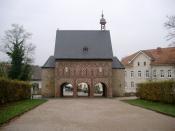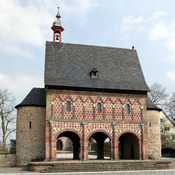Very few structures were constructed during the Carolingian period, and even fewer are still in existence. However, at the Abbey of Lorsch in Germany, existing now only in the form of ruins, the gatehouse known as the Königshalle, still stands. As one of the few remaining Carolingian structures, Königshalle has become a tourist attraction. Despite the date of construction of the Königshalle remaining unknown, Carolingian elements are evident in the impressive edifice. Furthermore, religion dominated the art and architecture of this period, and the Königshalle at the Abbey of Lorsch is without exception.
Short lived, the Carolingian period only lasted from the late 8th century through the early 10th century. Regardless of its relatively brief dominance, this period played a significant historical role, not only in the progression of art and architecture, but in religion as well. Charlemagne, Emperor of the Holy Roman Empire and the King of Franks, was the most important ruler of his time.
His reign resulted in many cultural and religious amendments, including his desire to unite all of Christianity, a unified code of laws, the establishment and maintenance of libraries, the institution of educational reforms, and most importantly, bringing the expansion of Islamic dominance to a halt (Adams, 2001, p. 175).
Originally, the Abbey of Lorsch was the private property of a noble family. Fearing legal allegations by his own family, one of its members, Gundeland, surrendered the Abbey to Charlemagne. Abbey of Lorsch, then becoming a royal monastery, inherited all of the rights, privileges, and obligations as such. Among these duties was the obligation to pray for Charlemagne's and his family's wellbeing, deploy support for Charlemagne's military proceedings, and pay tributes every year. The tributes paid by royal monasteries, including the Abbey of Lorsch, were a substantial portion of Charlemagne's economic success...

